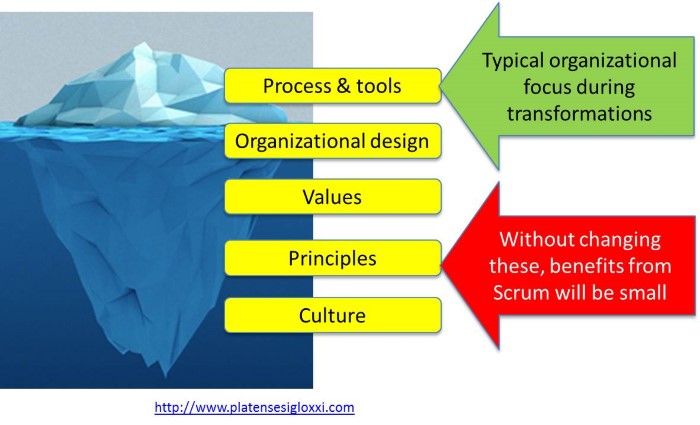Look below the surface (or you can sink)
During my experience as a Scrum trainer and agile coach, when it comes to embrace Scrum and Agile I’ve seen again and again people from these organizations to focus on aspects such as process, ceremonies, tools and setting up independent development teams. That is partly right, because understanding deeply Scrum is key to get the real benefit from it. But they often forget about the “soft part” about people, their values, principles and organizational culture. That is due to several reasons including:
- The current culture is “follow the process and stick to the hierarchy” so why bothering about culture?
- Values, principles and culture are difficult to identify and share.
- Common pessimism about being able “to change people”
I usually use the popular iceberg metaphor to communicate this idea.

Bottom-up change addresses better the people aspects…
Typical change management practices identify and “manage” risks around people, including values, principles and culture. Centralized “transformation groups” manage the process, including specific training and indicators to track the “soft” changes. While that helps, bottom-up change management addresses the matter much better because people are the primary actors discussing and implementing change.
The Scrum framework include five core values (courage, focus, commitment, respect and openness) and Scrum Master strive to make teams and individuals aware of their current values, principles and culture, and coach them to achieve sustainable changes. Teams inspect and adapt, again and again, during the Sprint retrospectives. Scrum Masters can share their progress, tips and issues around culture within communities of practice, a place where bottom-up change can “meet-in-the-middle” with changes driven by leadership.
…but sustainable changes in values, principles and culture need the leadership
When people face cultural change in middle and big organizations, they typically show highly skeptical about the chances of achieving it: “things have been like this for ages, and they are so difficult to change”. One very important tool than can help is a clear leadership message showing than culture must change. That usually makes people think than others will dare to change the status-quo.
Leadership must embody the cultural change and lead by example. That may require agile leadership training, like the one that Scrum.org trainers can provide.
Closing
We have seen that “hard” changes such as process, tools and organizational design must be backed by difficult changes in the cultural side. Organizational change is as good as the change within every member of the organization. Don’t allow “lipstick Scrum” and face deeper changes to achieve success.
